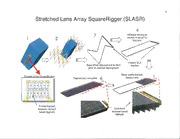
NASA Technical Reports Server (NTRS) 20060025026: High-Voltage High-Energy Stretched Lens Array Square-Rigger (SLASR) for Direct-Drive Solar Electric Propulsion PDF
Preview NASA Technical Reports Server (NTRS) 20060025026: High-Voltage High-Energy Stretched Lens Array Square-Rigger (SLASR) for Direct-Drive Solar Electric Propulsion
Source of Acquisition NASA Marshall Space Flight Center ISTS 2006 Kanazawa, Japan June 4-11, 2006 Joe T. Howell NASA Marshall Space Flight Center Huntsville, Alabama USA 1 1 ISTS 2006 Kanazawa, Japan June 4-11, 2006 Joe T. Howell John C. Mankins Mark J. O'Neill NASA Marshall Space Flight Artemis Innovation ENTECH, Inc. Center Management Solutions, Keller, Texas LLC Huntsville, Alabama USA Ashburn, Virginia USA USA Direct-Drive Solar Electric Propulsion (SEP) The Stretched Lens Array (SLA) offers these required performance metrics, and ground tests and flight tests to validate SLA for SEP are critical to near-term availability of this important technology for space exploration. 3 600 kW SL SR-Powered SEP Tug Mission ♦ SLASR-Powered SEP Tug • Nominal 600 kW SLASR Array F (Approx. 2,000 sq.m. Total) • Hall-Effect Thrusters • 600 Volt Direct Drive System ® 22 MT to Lunar Surface Each Trip ® 1 Year Max Round-Trip Time • Reusable Tug (5 Round Trips) ♦ Reusable Lunar Tug Mission ® Five Round-Trips (One per Year) from LEO (400 km) to LLO, with On-Board Chemically Fueled Lander Delivering Cargo to Lunar Surface • First LEO Launch Contains Tug, Xenon, Lander with Chemical Fuel, and Cargo • Subsequent LEO Launches Provide New Xenon, Lander with Fuel, and Cargo, Which Dock with Tug in LEO for Next Trip • 28 Degree Inclination Near Earth with Plane Changes Near Moon 600 kW SLASR-Powered Lunar SEP Tug Offers Conventional Chemical Cargo Transport Reusable SLA-Powered SEP Cargo Transport Item Mass Item Mass LEO-to-LLO Vehicle (Expendable) 10 MT LEO-to-LLO Vehicle (Reusable) 10 MT Cargo 22 MT Cargo 22 MT LLO-to-Lunar Surface Fuel 15 MT LLO-to-Lunar Surface Fuel 15 MT LEO-to-LLO Fuel 80 MT LEO-to-LLO Propellant (Xenon) 23 MT Total Launch Mass 127 MT Total Launch Mass (First Launch wNehicle) 70 MT Total Launch Mass (Subsequent Launches) 60 MT Total LEO Launch Mass for Five Deliveries Total LEO Launch Mass for Five Deliveries 635 MT 310 MT Over Five Years (110 MT Total Cargo) Over Five Years (110 MT Total Cargo) Launch Costs Using Shuttle-Derived Heavy $ 6,350 Million Launch Costs Using Shuttle-Derived Heavy $ 3,100 Million ($10 M/MT from ATK: safesimplesoon.com) ($10 M/MT from ATK: safesimplesoon.com) eBillion in avin s Just in Launch Costs per Additional Savings of 4 Fewer LEO-to-LLO Transfer Vehicles 5 akground: Mini-Dome Lens Array on PASP-Plus and SCARLET Array on Deep Space 1 Mini-Dome Lens Array Flew on SCARLET Array Flew on Deep PASP-Plus Flight Experiment in Space 1 in 1998-2001 and 1994-95 and Performed Very Well Performed Flawlessly for 38 in High-Radiation Elliptical Orbit Month Extended Mission 6 St-retched Lens Array (SLA) Approach Flexible Silicone Lens Folds Flat Against Radiator Sheet (Containing Solar Cells) for Compact Launch, and Deploys on Orbit Using Lengthwise Tensioning to Support Arched Lens in Proper Position 7 Unique Lens Provides High Optical Performance, Color-Mixing, and Unparalleled Error Tolerance Incidence Enlarged Angle View of Lens Emergence Angle Every Other Symmetrical-Refraction Prism Overlaps the "Blue" in Its Image with the "Red" in the Neighboring Prism's Image U.S. Patents 4,069,812, 6,031,179, 6,075,200 8 Two Versions of Stretched Lens Array (SLA) A^ M Flexible-Blanket Version (Above) of SLA Uses End Tensioning to Deploy and Support Lenses and Ving k^ UlIflitI'nIy T FM13.1i rai1cw, L-aui v..^ ui n ^.^ m) Radiator Blankets November 2002 Rigid-Panel Version (Above) of SLA Uses Pop-Up Lenses on Lightweight Honeycomb Panels 9 Stretched Lens Array SquareRigger (SLASR) 4 q All bays deploy as shown in detail for this one,„w ry^ Bays finish deployment & latch prior to blanket deployment Motor starts blanket Deployment complete 6 deployment 5^, sop 00 folded blanket between stowed Dual-deck tubes (typical) lens/cell panel blanket
